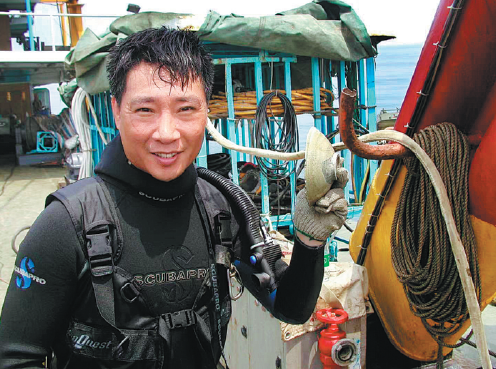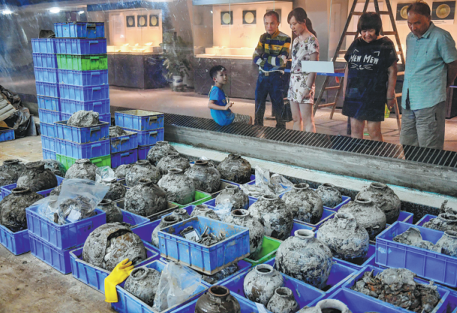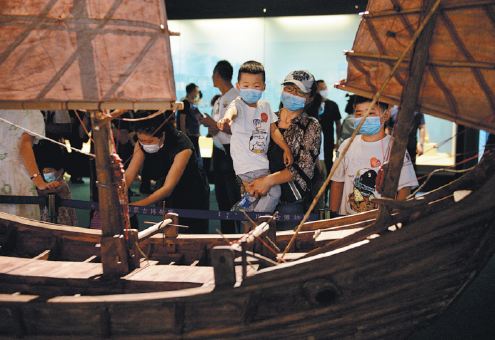Diving deeper into the past

China's marine archaeologists use pioneering techniques to preserve the nation's maritime history, Ye Zizhen reports.
Think of underwater treasure and your mind may well instantly fly to the idea of buccaneers on the high seas and looking for sunken ships laden with gold coins. However, another group of professionals, archaeologists, have often cast their eyes seaward in search of the big find, which is not really surprising given that 70 percent of the Earth's surface is covered by water.
In August 1987, a commercial shipwreck dating back to the Southern Song Dynasty (1127-1279) was discovered in the seas off Guangdong province, when a British company was looking for the merchant ship The Rheinburg. Among the 247 relics found on the ship were a gold belt and porcelain. The ship, about 30 meters long and with a beam of 10 meters, was later named Nanhai No 1 (Nanhai is the Chinese term for South China Sea).
Three months after the discovery, China, lacking archaeologists who could dive, decided to establish an underwater archaeology research center at the China History Museum, now known as the National Museum of China, in Beijing.
When the research center was founded, Cui Yong, a field archaeologist at the Guangdong Museum in Guangzhou, applied to work at the research center, eventually becoming one of nine archaeologists from Beijing and Guangdong who passed a rigorous physical examination.
"At the time, one of the questions was whether divers should be trained to be archaeologists or vice versa," Cui says. "Ultimately, the government decided to train archaeologists to dive because it was regarded as more efficient."
At the end of 1987, a specialist from Japan, Tanabe Sousan, head of the country's underwater archaeology research center, was invited to China to talk about his experience and expertise in underwater archaeology.
"Tanabe's lessons were more theoretical than practical, although he talked about many studies he had been involved with in Japan and other countries such as Syria," Cui says.
In 1989, 11 archaeologists from Beijing and the provinces of Guangdong, Shandong and Fujian, as well as the Guangxi Zhuang autonomous region, took diving lessons from Australian underwater archaeologists in Qingdao and became qualified divers.
"Being a good diver is not enough," Cui says. "Trusting colleagues and teamwork is critical when you're working underwater."
Underwater archaeologists work in pairs so they can properly deal with potential situations such as equipment breakdown and water disturbance.
In November 1989, a joint investigation team with Chinese and Japanese researchers was founded. However, because of poor weather and unfavorable water conditions, the research they were to carry out had to be called off.
From 1990 to 2000, Cui and others were doing underwater archaeology along the coastlines of Shandong, Liaoning and Fujian provinces, which Cui described as "a diagnostic tour" to reconnoiter the scale of the country's underwater treasure trove.
Research on Nanhai No 1 was not resumed until 2001, when there were enough experienced hands and adequate funds available.
"The ship is well preserved because it was buried under thick mud," Cui says. "However, it is that very mud, as well as low visibility, that adds difficulty to archaeological work."
Determining the ship's exact location, measuring its size and removing the mud could not all be done at the same time, because even the most skilled diver can only stay underwater for two hours at most.
However, in addition to those limitations, the work did not go as smoothly as planned, Cui says.
Between 2001 and 2004, eight separate investigations were conducted to find out the condition of Nanhai No 1 and the artifacts inside it.
"Because of the difficulty in doing archaeological work underwater, we decided to excavate the shipwreck as a whole and build a museum for it," Cui says.
Different shipwrecks call for very different archaeological methods. For example, in dealing with the wreck of Nan'ao No 1, found in the waters of Guangdong in 2007, the ship was left in the place it was found because it was only 1.5 meters under water and could be seen clearly.
However, the wreck of Huaguangjiao No 1, found in the waters of Hainan, was dissembled underwater and reassembled on land.
"What method archaeologists use depends on the condition and value of the ship, its environment and other considerations," Cui says.
In 2004, at the same time as the Guangdong Maritime Silk Road Museum on Hailing Island, 280 kilometers southwest of Guangzhou, was being built, the refloatation of Nanhai No 1 began.
"Deciding to build a museum for the ship was a huge risk, because we weren't even sure whether we could successfully refloat the wreck," Cui says.
In 2007, Nanhai No 1 was successfully extracted from water and moved into a purpose-built aquarium at the museum.
It has now been 34 years since Nanhai No 1 was discovered.
"Nanhai No 1 set a record in underwater archaeological history, as it was the first wreck of its kind to be refloated in its entirety in the world," Cui says.
"The 15 cabins were preserved quite well. It was the right decision to move it to the land. All the information on the ship is complete."
More than 180,000 artifacts were pulled from the water, including gold accessories, fine porcelain, silver ingots weighing more than 300 kilograms, and samples of food.
"Through these artifacts, you can see what food those on board ate and the hierarchy of the crew," Cui says. "The shipwreck itself is also valuable because it tells us a lot about the sailing and shipbuilding technology of the time."
Nanhai No 1 remains the oldest, largest and best preserved commercial shipwreck in the world that has been recovered from the sea.
The construction of the museum also became pivotal in driving the economic development of the city of Yangjiang, which Hailing Island is a part of. More than 800,000 visitors visited the museum in 2019, nearly triple the number that had been expected.
Cui, 59, will retire next year, with much of his career having been closely connected with Nanhai No 1.
"The excavation work is almost done, and the next plan is to preserve and protect the ship," he says.
China's coastline stretches out more than 18,000 kilometers, and the more shipwrecks are discovered, the more we learn about the maritime Silk Road.
Being involved in investigating a newly found wreck is the stuff of all underwater archaeologists' dreams, Cui says.
Contact the writer at yezizhen@chinadaily.com.cn
























